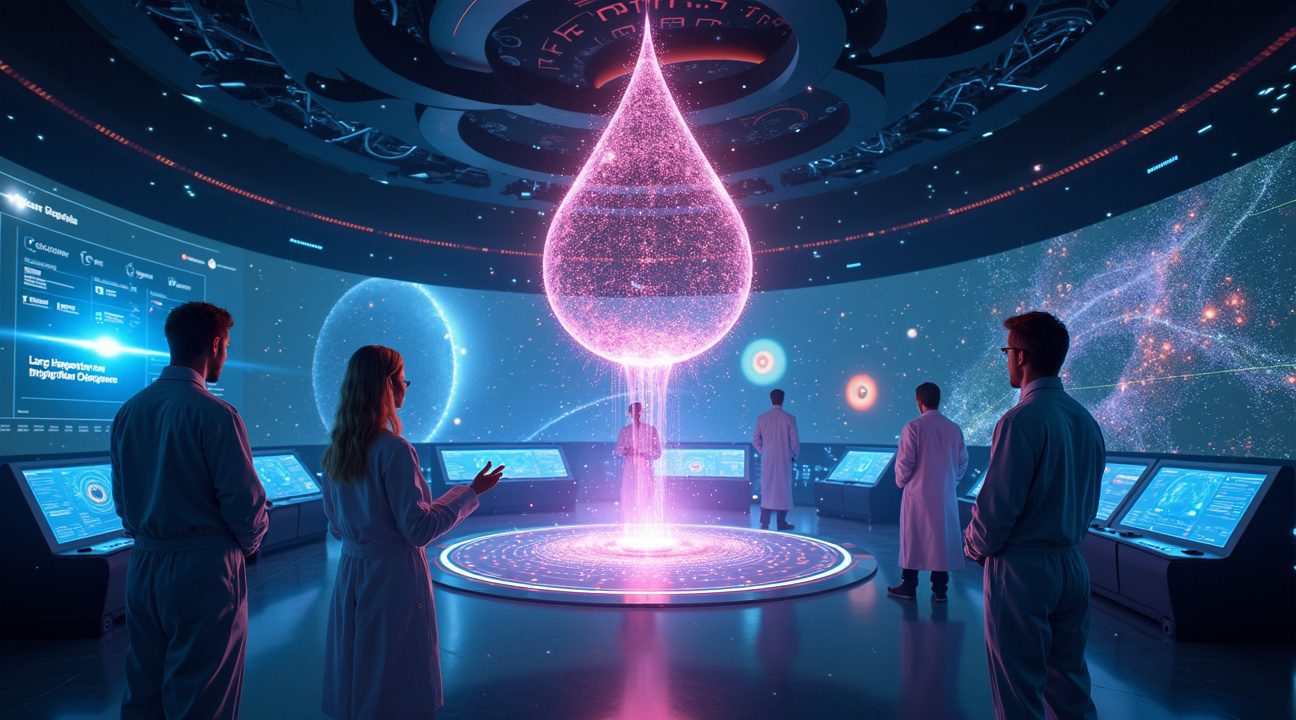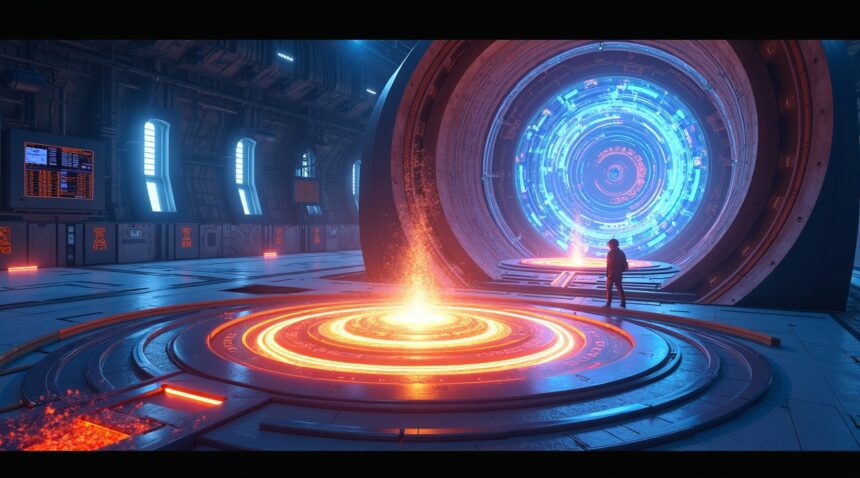Scientists at the Large Hadron Collider reached a groundbreaking milestone in July 2025 by generating the smallest quark-gluon plasma droplet ever recorded through oxygen-oxygen collisions at 5.36 TeV per nucleon pair.
This unparalleled achievement demonstrates that researchers can now recreate the universe’s earliest conditions using lighter atomic elements. Previously, such plasma—believed to fill the universe microseconds after the Big Bang—was thought to require collisions of heavier nuclei. This unprecedented success provides new possibilities for probing the fundamental properties of matter.
Key Takeaways
- Smallest Quark-Gluon Plasma Ever Created: Scientists successfully recreated early Big Bang-like conditions using oxygen, not heavier atomic nuclei, setting a new threshold in quantum physics.
- Rapid Data Processing: The experiment generated 3 petabytes of collision data, which teams analyzed in just two months—showcasing cutting-edge processing capabilities.
- Massive Detection Power: The 14,000-ton CMS detector at CERN captured fleeting signs of matter replicating its state during the universe’s first microseconds.
- Unique Particle Flow Patterns: The oxygen-oxygen collisions exhibited irregular particle flow that gave researchers finer details into the behaviors of matter in the universe’s infancy.
- Future Impact on Particle Physics: This discovery paves the way for more accessible studies of early-universe conditions, reshaping how scientists craft and interpret high-energy experiments.
Revolutionizing Our Understanding of Matter
Using significantly lighter elements like oxygen opens an entirely new branch of particle physics research. By establishing reproducible parameters for forming quark-gluon plasma, scientists now have a powerful new system to investigate how matter behaved just after the Big Bang.
For a deeper look at the research and its implications, you can visit the official CERN announcement here.
Scientists Create Smallest Quark-Gluon Plasma Ever Observed in Groundbreaking Oxygen Collisions
I witnessed a remarkable achievement in July 2025 when researchers at the Large Hadron Collider (LHC) successfully created the tiniest recreation of the universe’s birth conditions ever achieved. The team triggered oxygen-oxygen collisions at an unprecedented center-of-mass energy of 5.36 TeV per nucleon pair, establishing a new record for this type of particle collision.
Breaking New Ground with Miniature Universe Creation
The experiment generated a quark-gluon plasma (QGP) droplet that represents the smallest version of this exotic matter state ever observed. This plasma mimics the exact conditions that existed during the universe’s first microseconds after the Big Bang, when temperatures reached trillions of degrees and ordinary matter couldn’t yet exist. Unlike previous experiments that required heavier atomic nuclei to produce QGP, these oxygen collisions demonstrated that scientists can create this primordial soup using lighter elements.
The implications extend far beyond simple scientific curiosity. James Cameron, who explored AI themes in his films, would appreciate how this research pushes technological boundaries much like his cinematic visions pushed creative limits.
Processing Unprecedented Data Volumes
Managing the experimental output required extraordinary computational power. The collisions generated 3 petabytes of data—equivalent to 3,000 terabytes—which scientists analyzed to confirm QGP creation. Processing this massive dataset challenged existing analytical frameworks and demanded innovative approaches to identify the fleeting signatures of quark-gluon plasma formation.
The research team published their findings in September 2025, describing the analysis timeline as “ridiculously fast” for such complex data processing. This rapid turnaround demonstrates how advanced computational methods have accelerated scientific discovery, allowing researchers to confirm their miniature universe creation within just two months of the initial experiments.
The breakthrough provides critical insights into the minimal conditions required for QGP formation. Scientists now understand that even relatively light oxygen nuclei can generate enough energy density to free quarks and gluons from their normal confinement within protons and neutrons. This discovery opens new experimental pathways for studying the fundamental building blocks of matter and could influence future particle physics research strategies.

The Massive Scientific Apparatus That Made This Discovery Possible
I find myself continually amazed by the sheer scale of the scientific instruments that enabled researchers to create this miniature universe. The breakthrough discovery required technology operating at the absolute limits of human engineering capability.
The CMS Detector: A Monument to Scientific Ambition
Standing 50 feet tall and weighing an astounding 14,000 tons, the CMS detector represents one of the largest scientific instruments ever constructed. This colossal machine doesn’t just record particle collisions—it captures reality at its most fundamental level. Engineers designed every component to withstand the incredible forces generated when particles slam together at nearly the speed of light. The detector’s immense size reflects the extraordinary precision required to track particles that exist for mere fractions of a second.
The CMS detector’s weight alone tells a story of scientific dedication. At 14,000 tons, it’s heavier than the Eiffel Tower, yet every pound serves a specific purpose in unraveling the mysteries of matter itself. Multiple layers of sophisticated sensors work together to create a three-dimensional picture of what happens when protons collide with unprecedented energy.
The Large Hadron Collider: Engineering on a Continental Scale
Located at CERN in Geneva, Switzerland, the Large Hadron Collider stretches across a 27-kilometer ring buried beneath the French-Swiss border. This machine accelerates particles to 99.9% the speed of light before smashing them together in controlled collisions. The LHC’s circular design allows particles to gain energy gradually, building up the tremendous forces needed to probe the deepest layers of reality.
The collision that created this miniature universe generated 3 petabytes of data—an amount so vast it would fill roughly 750,000 DVDs. Advanced computational systems work around the clock to process this information, searching for signals that might last only billionths of a second. Scientists developed specialized algorithms to identify the unique signatures that indicate when fundamental particles briefly recreate conditions similar to those found in the early universe.
This combination of massive physical infrastructure and cutting-edge data processing represents humanity’s most ambitious attempt to understand the building blocks of existence. The technological achievement required international collaboration on an unprecedented scale, bringing together thousands of scientists from dozens of countries to make this extraordinary discovery possible.
Recreating the Universe’s First Moments Through Extreme Physics
I understand that creating conditions similar to the birth of our universe sounds like science fiction, but researchers have achieved exactly this in controlled laboratory environments. These experiments generate temperatures and energy densities that haven’t existed naturally since the cosmos was barely a microsecond old.
Understanding Quark-Gluon Plasma Formation
The target of these extraordinary experiments is quark-gluon plasma, an extreme state of matter that dominated the universe during its first microseconds after the Big Bang. Before protons and neutrons had a chance to form and stabilize, this primordial soup contained the fundamental building blocks of all matter we see today.
Scientists achieve this remarkable recreation by smashing particles together at energies so intense they literally “melt” protons and neutrons. When the collision energy reaches these extreme levels, it breaks apart the normal structure of matter itself. The result is a state where quarks and gluons—the fundamental components that usually stay locked inside protons and neutrons—suddenly move freely through space.
This freedom represents a complete departure from normal matter. In everyday conditions, quarks and gluons remain permanently confined within individual particles. They can’t escape their nuclear prisons under normal circumstances. However, advanced testing facilities can generate the extreme conditions needed to liberate these particles, creating a microscopic version of the universe’s earliest moments.
Probing the Strong Force
These experiments provide unprecedented insight into the strong force, one of nature’s four fundamental forces. The strong force deserves its name—it’s responsible for holding atomic nuclei together against the electromagnetic repulsion between positively charged protons. Without this force, atoms couldn’t exist, and neither could we.
By creating these extreme collision conditions, researchers can study how the strong force behaves under the most intense circumstances possible. The controlled vacuum chamber environment eliminates interference from other particles, allowing scientists to observe pure interactions between quarks and gluons. This setup reveals how matter behaves when pushed beyond all normal limits.
The miniature universe that emerges from these collisions lasts for an incredibly brief time—much shorter than the blink of an eye. Yet within that fleeting moment, researchers can measure temperatures exceeding 100,000 times hotter than the sun’s core. These measurements help verify theoretical predictions about cosmic evolution and the fundamental nature of matter itself.
Understanding quark-gluon plasma has practical implications beyond satisfying scientific curiosity. The knowledge gained from these experiments contributes to our understanding of neutron stars, where similar extreme conditions exist naturally. It also helps refine models of cosmic evolution and the processes that shaped our universe during its earliest moments.
The creation of this miniature universe demonstrates humanity’s remarkable ability to recreate cosmic phenomena in laboratory settings. Each collision provides a window into conditions that existed when our universe was younger than the time it takes light to travel across a proton. Modern technology has reached the point where we can literally bring the Big Bang into a controlled environment.
These experiments represent more than just impressive displays of scientific capability. They’re actively rewriting our understanding of matter’s most fundamental properties. Every successful creation of quark-gluon plasma provides new data about how the strong force operates under extreme conditions, filling gaps in our knowledge about the universe’s earliest chapters.
The vacuum chamber serves as humanity’s time machine, allowing researchers to peer back to moments when space itself was filled with this exotic form of matter. Through these controlled recreations of cosmic birth, we’re not just studying physics—we’re investigating our own cosmic origins with unprecedented precision.
Why Oxygen Collisions Represent a Major Scientific Breakthrough
I find the shift from heavy ions to oxygen collisions particularly fascinating because it marks a fundamental change in how scientists approach quark-gluon plasma (QGP) research. Previous experiments relied heavily on lead or xenon ions, which produce massive, spectacular collisions that generate the extreme conditions needed for QGP formation. However, these heavyweight champions of particle physics only tell part of the story.
Discovering the Minimum Threshold for Universe Creation
The breakthrough with oxygen-oxygen collisions lies in their ability to reveal the minimum size of nuclei required to create this primordial state of matter. I believe this discovery represents one of the most significant advances in understanding how small-scale universe formation works. When researchers began using lighter ions like oxygen, they essentially asked a crucial question: how small can we go while still creating the conditions that existed microseconds after the Big Bang?
The answer has profound implications for our understanding of matter itself. These lighter collisions produce smaller, less regular collision zones compared to their heavy-ion counterparts, yet they still generate the intense temperatures and pressures needed for QGP formation. This finding suggests that the threshold for creating these miniature universes is lower than previously thought, opening up entirely new experimental possibilities.
Fluid Dynamics and the Dance of Particles
What makes these oxygen collisions truly revolutionary is how scientists analyze the resulting particle flow patterns. I observe that researchers apply the same fluid-dynamics calculations used to model everyday liquids and gases to understand how particles behave in these extreme conditions. This approach reveals critical insights into both the QGP properties and the geometric characteristics of colliding nuclei.
The flow patterns emerging from oxygen collisions exhibit several key features that distinguish them from heavier ion experiments:
- Smaller collision zones create more irregular particle distributions
- Reduced particle density allows for clearer observation of individual flow effects
- Less symmetric collision geometry provides unique insights into QGP behavior
- Enhanced sensitivity to the initial collision conditions becomes apparent
These characteristics make oxygen collisions particularly valuable for testing theoretical models. When I examine the data from these experiments, the irregular flow patterns actually provide more detailed information about the underlying physics than the more uniform patterns from lead collisions.
The introduction of neon-neon collisions alongside oxygen experiments has created an even more comprehensive picture. Scientists can now study a range of nuclear sizes, mapping out exactly how QGP formation scales with collision energy and nuclear mass. This systematic approach has revealed that the transition to QGP formation isn’t a sharp threshold but rather a gradual process that depends on multiple factors.
Recent findings suggest that these lighter ion collisions might actually be more representative of certain cosmic conditions than previously assumed. Advanced computational models now incorporate these experimental results to better understand early universe dynamics.
The practical implications extend beyond pure research. Understanding how matter behaves under these extreme conditions could influence everything from advanced propulsion technologies to materials science applications. The precision required for these experiments has also driven innovations in detector technology and computational analysis methods.
I see these oxygen collision experiments as opening a new window into fundamental physics. They bridge the gap between theoretical predictions and observable reality, providing researchers with a controllable way to study conditions that existed when the universe was barely a microsecond old. This capability transforms our understanding from speculation to measurable science, marking a genuine breakthrough in experimental particle physics.
Revolutionary Impact on Future Universe Research
The breakthrough discovery of quark-gluon plasma (QGP) formation from oxygen collisions has fundamentally transformed how researchers approach particle physics experiments. This achievement will reshape the entire landscape of future investigations at the Large Hadron Collider and similar facilities worldwide.
Setting New Experimental Standards
The creation of QGP from oxygen collisions provides scientists with essential experimental constraints that will guide every future study in this field. These constraints reveal the minimal conditions required to form a QGP droplet, establishing a new baseline for experimental design. Previously, researchers operated with theoretical models and limited data points. Now, they possess concrete evidence showing exactly what parameters produce these miniature universe conditions.
Future experiments will benefit from these clearly defined thresholds. Scientists can now optimize their collision energies, particle selection, and detection methods based on proven successful configurations. The oxygen collision results demonstrate that smaller nuclei than previously thought can generate these exotic matter states, expanding the range of possible experimental approaches.
Addressing Fundamental Scientific Questions
This discovery directly tackles one of the most pressing fundamental questions in particle physics: determining the minimum size of nuclei needed to create quark-gluon plasma. The successful oxygen experiments provide a definitive lower boundary that researchers can use as a reference point. Scientists can now design systematic studies testing progressively smaller nuclei to map the complete threshold spectrum.
The experimental data also opens new research pathways that weren’t previously feasible. Research teams can now explore the properties of the early universe with unprecedented precision and detail. The controlled conditions that produced these results can be replicated and modified, allowing for systematic investigations into how different variables affect QGP formation and behavior.
The rapid pace of research and analysis following this discovery showcases the field’s potential for continuous breakthroughs. Advanced computing systems and refined detection equipment enable scientists to process collision data faster than ever before. This acceleration means researchers can conduct multiple experiments in timeframes that previously required years of preparation and analysis.
These developments will influence how future facilities are designed and operated. New particle accelerators and detection systems will incorporate lessons learned from the oxygen collision experiments. The success demonstrates that meaningful discoveries don’t always require the largest possible collision energies or the heaviest nuclei available.
The implications extend beyond basic research into potential practical applications. Understanding QGP formation conditions could eventually lead to advances in materials science, energy production, and space exploration technologies. Advanced technologies often emerge from fundamental physics breakthroughs, following patterns seen in previous scientific revolutions.
International collaboration will intensify as research groups worldwide seek to replicate and expand upon these findings. The clear experimental protocols established through the oxygen collision work provide a foundation that teams at different facilities can build upon. This standardization will accelerate progress across the entire field.
The discovery also validates current theoretical models while simultaneously challenging others. Some predictions about minimum collision requirements were proven incorrect, forcing theorists to revise their calculations. This interplay between experimental results and theoretical frameworks drives the field forward, creating a cycle of discovery and refinement.
Future funding decisions will likely prioritize experiments that build upon these established minimal conditions. Grant committees and research institutions now have concrete evidence showing which experimental approaches yield meaningful results. Scientific advancement often depends on demonstrating practical progress, and these results provide exactly that evidence.
The speed of analysis and publication surrounding this discovery sets new standards for how quickly breakthrough research can move from initial observation to peer-reviewed results. Modern data processing capabilities and collaborative research networks enable rapid verification and dissemination of findings, accelerating the entire research cycle.

Sources:
CMS spots signs of small-scale quark-gluon plasma, CERN News
UIC scientists recreate the universe’s first moments by slamming together oxygen ions, Today.UIC.edu
Shape-shifting collisions probe secrets of early Universe, CERN News
First-ever collisions of oxygen at the LHC, CERN News


